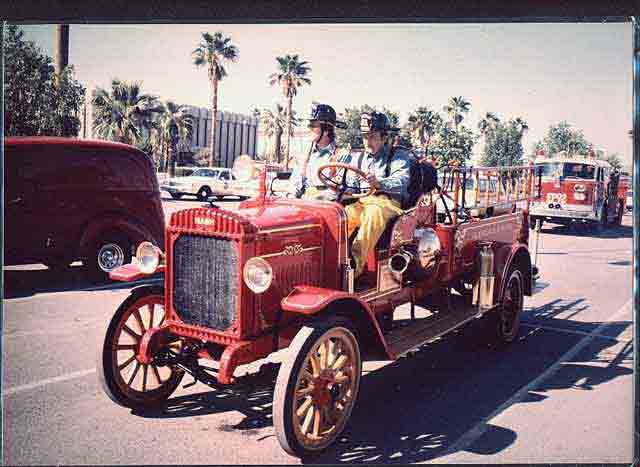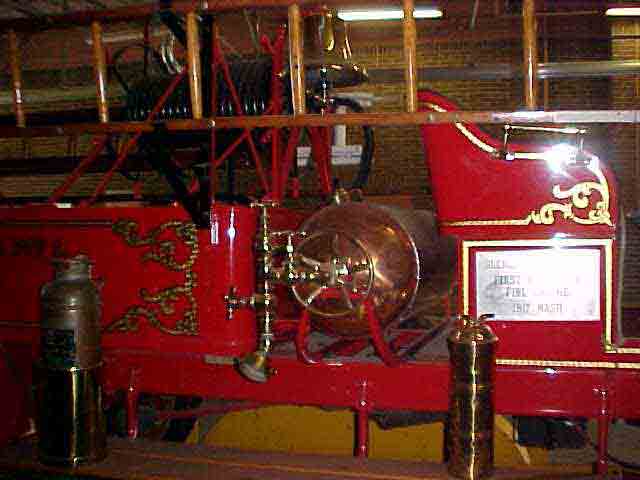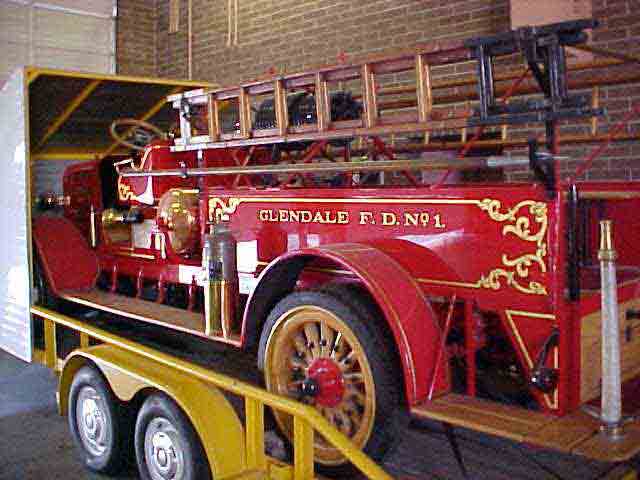
<—– Back to Articles and Extracts
(Mike E. Bailey)

NOTE: This article is in the process of being restored.
The Glendale Fire Department had the truck for nine decades at the time this was written. It’s actually over a century now.
The photographs seem to be long gone and most of the links are dead. This is something that goes along with a website that’s 15 years old. Some stuff gets lost an there’s not a lot of chance to get it back. This truck is the original fire truck at the Glendale, Arizona Fire Department, so I want to try to get some more pictures of it at some point. Some of these links go to The AMC Heritage Forum, which used to be part of this site, but really doesn’t exist anymore without a lot of forensic database work on my part. Will it ever be resurrected? Only time will tell. I believe I originally wrote this article in 2007.
Here is some information and a few pictures of the truck on the Nash Car Club of America web site, by an employee of the Glendale Fire Department from 2002:
http://www.nashcarclub.org/nccaphot/trucks/ga_fire.html
Hi Jim,
My name is Patty Frey and my husband Ray has been e-mailing you about the 1917 Nash Fire Truck that the fire department I work for owns.
Unfortunately I do not have a lot of information on the history of the Nash.
I do know that it is a Peter Pirsh-built Nash chemical and hose wagon.
Our department purchased it new in 1917.
It was our department’s first motorized fire apparatus.
There is a plate on the dash that reads the following:
Model #3017
Truck # 98745
Max. Speed 16 mph.
The normal freight load capacity is 4000 lbs.,
The normal body weight allowance is 1050 lbs.,
The normal weight of the chassis is 3850 lbs.,
And total weight of the chassis, body & load is not to exceed 8900 lbs.
The bottom of the plate reads, “The Nash Motors Company”.
It is 2 wheel drive with solid rubber tires.
We are in the process of repairing the vehicle and do understand that we need to keep the historical value in mind.
When we get it running again we will be getting it appraised and properly insured.
More than likely there will be a general order or department policy on who is allowed to drive, touch, or work on the Nash. If it were possible, and we had some lobby space, we would showcase it year-round for citizens that come by to enjoy, instead of keeping it on a trailer in one of our station apparatus bays collecting dust.
We will definitely do what is right to keep the value of such a valued member of our department.
If any members get to the Phoenix area, (I am sure some are Arizona snow birds)they are more than welcome to give me a call or e-mail me when they will be in town and I can meet them at the station that we house our Nash.
Thanks for all of your knowledge and help.
Patty Frey”
The City of Glendale, Arizona recently allowed us to view and photograph their fire department’s first piece of motorized fire equipment, Engine No. 1…



XXXXXXXXXXXXXXXXXXXXX
1917 Nash Model 3017 2 Ton Chemical Fire Engine
Photo by Route 66 Rambler
Glendale, Arizona, pleasantly situated near the western mountains of Arizona’s Salt River Basin, is its state’s fourth largest city.
The population shown in the 2005 census is just shy of 250,000. The city is host to the NHL’s Phoenix Coyotes, the NFL’s Arizona Cardinals, and several spring training teams.
University of Phoenix Stadium in Glendale, Arizona
In January of 2008, Glendale will be proudly hosting the Super Bowl championship game of the National Football League, in the league’s most modern, luxurious, and technically advanced stadium.
Close by is Luke Air Force Base, named for Frank Luke, a daring fighter pilot who died in the WWI war effort, with the highest record in the war for balloon aces, and the first aviator to recieve the medal of honor.
From a website for the 944th Fighter Wing
Luke AFB is the world’s largest aircraft training station, training international and American pilots in the finer points of the fighter pilot’s craft. This is also the world’s largest concentration of the F-16 Fighting Falcon fighter jet. There is a Military Airlift Command wing there, and several large reserve and foreign training units.
The City of Glendale is also proud to play host to another national treasure, an amazingly durable and colorful symbol from the early years of modern industrial America…
photo by Route 66 Rambler
This is a 1917 Nash Model 3017 2-Ton Chemical Truck, bought new by the City of Glendale in 1917. This was a time when the biggest cities in the Midwest became the important centers of their regions which we know today, but where much of the West was still rugged, dangerous, and poorly supplied. While the road system had expanded drastically in the previous ten years, travel by auto was still dangerous and difficult in the west…
from the 1969 American Motors Family Album, by John Conde
The Hudson branch of the AMC Family Tree
experienced extremely primitive roads in the West, on this transcontinental round trip in 1916.
The year was 1917, and the country was in a dark mood, as it began to slide, then tip over the edge, and into a bitterly roiling World War I. One of the primary rallying points at this time was the German sinking of the RMS Lusitania.
Charles T. Jeffery, one of the heirs to the Rambler Empire of Thomas B. Jeffery, and president of The Thomas B. Jeffery Company, actually survived this incident. This is covered in the topic,
Charles T. Jeffery’s Almost European Tour
This harrowing incident caused Jeffery to consider his position in life, and led the stockholders to sell the Jeffery Company to Charles Warren Nash in 1916. Here are Charles T. Jeffery, on the left, and Charles W. Nash, on the right, during the time of the deal:
Nash had recently left the presidency of General Motors in order to purchase his own car company.
A general military draft had been instituted, and to offset the expense of the war effort, the nation’s first income tax had been enacted. At least the government had let it be known that the tax would be temporary.
from the 1969 American Motors Family Album, by John Conde
In Glendale, things were beginning to change for what was then a tiny desert town of about 3500, existing primarily because of its intersection between railroad, water, and wagon trail. The first dirt roads and trails were beginning to be paved in from Phoenix, another small town, at the rail junction with the transcontinental railroad.
picture from the City of Glendale website at: glendaleaz.com
The city of Goodyear had been founded in 1917, a few miles to the southwest of Glendale, by the Goodyear Tire and Rubber Company, to farm enough of a special hybrid cotton, to meet the explosion in demand for use in military, aircraft, and automobile tires. Originally it was known as Egypt, because of the flooding Gila River, and the acres of cotton with workers in the fields.
From the City of Goodyear’s website:
About Goodyear
History
The Goodyear of today exists because of the cotton of yesteryear. It was part of the 16,000 acres purchased in 1917 for the Goodyear Tire and Rubber Company by junior executive Paul Litchfield. Cotton used to make rubber tires for airplanes in World War I was in short supply because foreign sources were in war torn countries or disease ridden.
Truck Shortage-
This magazine ad, for New York City area Nash Trucks dealers from 1917, brings up an important point about our 1917 Nash Fire Truck.
Route 66 Rambler collection
The ad shown above mentions a “truck shortage”…. The United States was in the process of entering the Great War at this time, and just like World War Two, rationing was instituted on those commodities which were necessary for the war effort. Commercial truck production was severely limited, as the military needed all the trucks they could get, for initial mobilization of the armed forces for entry into the war.
This means that Glendale Fire Department’s 1917 Nash, would have been an exception to this rationing, specially granted by the government as a vehicle which was necessary to the war effort on the home front. Another applicant for a commercial truck, would not receive their truck that year, so that Glendale’s volunteer force could have their first piece of motorized fire equipment.
Elsewhere in The AMC Heritage, these types of Hudson commercial trucks were much in demand for the war mobilization effort in 1917:
1917 Hudson Military Troop Transport 1917 Hudson Military Ambulance
This picture shows later, professional firemen of the 1950’s, standing proudly next to their antique pride and joy…
photo courtesy of the Glendale, Arizona Fire Department
This truck was acquired just ten years after Long Beach, in the Los Angeles Area, bought the first motorized fire equipment on the west coast, a 1907 Rambler. Their chief’s car was also a Rambler.
The 1907 Long Beach fire truck is discussed on The AMC Heritage Forum, in the Topic,
1907 Rambler Fire Truck- Long Beach Fire Department under Rambler Trucks, in The Original Rambler:
:
Nash in this first year was the world’s largest truck builder, thanks to The Thomas B. Jeffery Company, and was almost the only one providing trucks of any kind to the public during the war. Europe was in the depths of WWI at this time, and Nash was busy selling Quads to all sides involved, not to mention the armored car program, which was licensing countries to build the Jeffery Armored Car design onto the Nash Quad chassis that these countries were buying.
Jeffery Armored Car by Harold W. Jeffery The Jeffery Armored Car was built on the Quad chassis
France, the UK, Germany, Russia, Poland, Czechoslovakia, were all buying the Quad, at least until the U.S. Government began taking their quota of production, and/or licensing the armored car patents to build the armored car onto at least some of these trucks.
1916 Jeffery-Poplavko Armored Car(Poland)
This means that the vast emphasis of truck production at the Jeffery/Nash plants was focused primarily on the Quad truck, during the WWI years. Consequently, the two-wheel-drive trucks were extremely rare. AMC lists truck production for 1917 at 3,000 units. Surely that does not account for Quad production at the time. The 3,000 truck figure must be for standard, two-wheel drive trucks. Sources provide figures as high as 11,000 Quads during 1916 alone.
photo by Route 66 Rambler
After seeing the pictures of the Nash pickup truck that Forum Member mramc posted in the Topic Nash Trucks,
I was looking at nashcarclub.org, hoping for more pictures of Nash pickups, when I spotted this 1917 Nash fire truck, owned by the City of Glendale, Arizona, less than 20 miles from my house:
photo found at nashcarclub.org
We called the Fire Department in Glendale, and were told the truck would be out for a parade in a couple of weeks. We set up a meeting to get photos and some background on the truck’s City history. This is the page where Glendale’s 1917 Nash Fire Truck is featured, on the Nash Car Club of America’s site at::
http://www.nashcarclub.org/nccaphot/trucks/ga_fire.html
The lady who originally submitted the information to the site is now a deputy chief with the department.
Relevant information on the specifications of the truck:
photo by Route 66 Rambler
Model #3017
Truck # 98745
Max. Speed 16 mph.
The normal freight load capacity is 4000 lbs.,
The nomal body weight allowance is 1050 lbs.,
The normal weight of the chassis is 3850 lbs.,
And total weight of the chassis, body & load is not to exceed 8900 lbs.
The bottom of the plate reads, “The Nash Motors Company”.
It is 2 wheel drive with solid rubber tires.
Deputy Chief Pat Berkel of the Glendale Fire Department sent in some photographic evidence that Nash is Santa’s preferred brand:
photo courtesy of the Glendale, Arizona Fire Department
He also sent in a few more pictures of Glendale’s Nash Fire Truck, showing the truck still in service in the 1950’s. This is Station #1, the only one at the time. The town is so small the civic center is part of the same building. Glendale is now Arizona’s 4th largest city, at just shy of 250K population in 2005. I can’t quite place the make of car showing the tail at the left of the photo…
Here you can see the bucket brigade trailer(remember, it’s Arizona), Engine #1, the ’49 Chevy Fire Truck, which Glendale no longer has, and beyond that, the sedan delivery chief’s car, which I am sure saw plenty of miles in its time.
photo courtesy of the Glendale, Arizona Fire Department
I am now officially a big fan of this truck.
photo courtesy of the Glendale, Arizona Fire Department
The truck was in service for at least 40 years. This old Nash, Engine No. 1, is very heavy duty for its size and time, with a two-ton capacity. It was restored several years ago through department-wide participation in the effort. The firemen performed the work themselves, in the station to which No. 1 was assigned at the time. It was a top-notch job, done out of love.
photo by Route 66 Rambler
photo by Route 66 Rambler
Nevertheless, in some pictures you will find stains, scuffs or leaks on the truck and its equipment. This is because the truck is operated on a regular basis for displays, parades, or training. Its normal operating environment in southern Arizona is one of the most hostile known. Imagine a Fourth of July parade in the Sonoran Desert. Say six miles of constant stop and go, in temperatures that are regularly above 112 at that time, and have exceeded 120 degrees.
photo found at nashcarclub.org
There’s a lot of agriculture and construction, so dust is another severe duty condition this truck seems to take with ease. Essentially, this is a faithful and authentic look at the condition the Late Brass Age truck would have been in, while in operation in 1917.
photo by Route 66 Rambler
Obviously, it’s not responding to fires anymore, but it does still operate regularly, and the Sonoran Desert has not gotten any kinder in the the truck’s nine decades in the area. It is powered by a Nash Twin-Ignition big four. At the moment displacement is unknown, but research should be straightforward.
photo by Route 66 Rambler
When we visited, Engine No. 1 was being cleaned and serviced in preparation for its next assignment, Glendale’s 25th Annual Fire Safety Parade. Deputy Chief Pat Berkel was our host to view the truck. He is one of the last who are still with the department from the time of the Nash’s restoration.
He was very professional and friendly, and of course turned out to be a bit of a car guy. At the moment the electric starting mechanism, optional for the time, is out of the truck. But Mr. Berkel told us it takes around four healthy cranks with the hand starter, and it’s chugging away, top speed 16 mph.
photo by Route 66 Rambler
According to our host, the can on the right contained an activation agent for the chemical fire-fighting slurry which was stored in the large copper tank. The slurry was mixed with water in the tank, for later use at a fire scene. To activate the chemical fire-fighting compound, a measured amount of the activation agent was poured from the brass can on the right, into the top of the copper tank.
photo by Route 66 Rambler
Then the steering-wheel-like handle was used to rotate the tank several times to stimulate the chemical reaction which produced the fire-fighting compound. The resulting pressure from the chemical reaction was used to expel the chemical onto a fire, using the large brass valve manifold to direct the mixture into hoses, or to take on water in the tank to rinse it and mix another batch.
photo by Route 66 Rambler
Engine No. 1 was a real prize, for what was then a tiny volunteer force in a small, remote Western town. This force would remain volunteer for two and a half decades, until the 1930’s, and this truck was a prized and vital piece of equipment, serving for at least 20 more years, into the 50’s. This old Nash served a fine example to the firemen it carried into service. It is much-loved, and a treasured member of the Department.
photo by Route 66 Rambler
Yes, that is Genuine Gold Leaf, hand rubbed with a wooden dowel, to resemble a machined surface. Hand pin-striped over lovingly hand-rubbed lacquer.
photo by Route 66 Rambler
I’ve got about 60 pictures of this Late Brass Age treasure, with some commentary, in its own photo album in the RustBucket:
photo by Route 66 Rambler
I felt it was a privilege to have a chance to experience this gorgeous rolling museum piece up close, and hope the photos will share the moments spent with a truly unique piece of early automotive history, and the early history of Arizona.
Thank you to the City of Glendale, its Fire Department, and Deputy Chief Pat Berkel for a great afternoon, and for preserving a priceless glimpse at the past.
-mike
Update:
After reading this article, visitor Ken Kafka sent this photo of his 1918 Nash Model 3019 Two-Ton Truck, in beautiful shape, faithfully performing the very delicate task of Royal Coach…
Ken is now a Member of The AMC Heritage Forum.
-Michael Bailey

